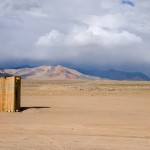Murghab, also spelled Murgab, is a remote town hidden within the deserted high Pamir plateau in the Gorno-Badakhshan Autonomous Region. Home to just four thousand permanent residents, this isolated little town, located 3,650 meters above sea level, is also the highest village in Tajikistan.
With a barren landscape and less than favorable weather conditions – blistering summer heat and freezing winters – there is little reason to visit Murghab besides some several famous archaeological sites. One of the most famous of these landmarks along the Pamir Highway is the Plateau Shakhty Cave that is home to some magnificent examples of ancient rock art paintings. This little cave, located around 50 kilometers away from the town of Murghab in the Kurteskei Valley in the Pamir Mountains of Tajikistan, is well worth exploring.
While the caves date back tens of thousands of years, they were only uncovered in the late 1950s – by accident. A group of Soviet archaeologists who were researching another site in the area were caught in a terrible storm and had to take cover in an overhang they found, now known as the caves at Shakty.
After spending the night in the cave, they woke up to find the cave walls were filled with some of the best-preserved rock art paintings they had ever seen. The art, painted many thousands of years ago with a red mineral pigment, depicts a bear hunting scene with double-tipped swords and what appears to be an odd merging of a man and a bird.
Little is known about the people who created these ancient pieces of rock art. However, various archaeological reports and studies have given us a close estimate. Despite often being referred to as Neolithic art, according to the studies of G. Kuhn, the themes and semi-figurative style are closer in likeness to Paleolithic art.
However, as it is unlikely that these paintings could have been created before the first humans arrived in the Eastern Pamirs, believed to be somewhere between 8,000 and 5,000 B.C, the Shakhty Cave rock paintings are actually more likely to be from the Mesolithic era.
The fascinating Mesolithic paintings at Shakhty Cave can be seen today with a day trip from Murghab. Heading towards Khorog, a turning onto a remote gravel track will eventually lead to the site of the Shakhty caves, located in a V-shaped valley surrounded by endless V-shaped valleys and an arid landscape with very few landmarks.
For this reason, it is nearly impossible to find the Shakhty caves on your own, and the best way to see them is to engage the services of a knowledgeable guide – something that Paramount Journey will be happy to assist you with.
When you have pinpointed the right valley, the Shakhty Caves Tajikistan is just a short five-minute clamber up a steep rock-strewn hill. Located at an altitude of 4,200 meters, these rock paintings are believed to be the highest located rock art paintings in the world.
While the majority of the Shakhty Cave’s rock art remains brilliantly preserved, there are some that have weathered too much to be visible. Therefore, visitors are encouraged to stay away from the walls and avoid touching them to avoid causing more damage to these fascinating pieces of prehistoric artwork.
Visiting the Shakhty Cave ancient rock art sites can be combined with many of Paramount Journey’s tours, such as more in-depth Pamir hiking trips. Take a look at our website for more ideas and itineraries.

























